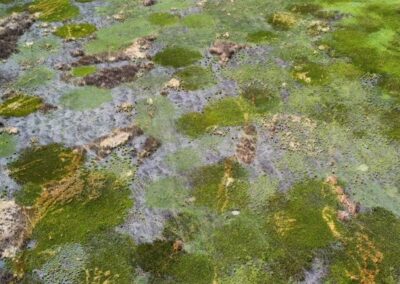by Dr. Stephano Haarhoff
Rainfed and irrigated cropping systems face the challenge of adapting to a hotter and drier climate across the South African agricultural sector. Seasons between the drier cycles may be very wet, offering different challenges. Regenerative Agriculture (RA) can be implemented as an adaptive approach to build climate-smart farming systems that are more resilient against erratic rainfall patterns and address soil health concerns while conserving the environment.
Regenerative Agriculture principles, which include crop diversification, maintenance of organic soil cover by plants or mulch, no- to-minimum soil disturbance and livestock integration, are aimed at improving biodiversity (below and above ground), water use efficiency and improved yields. The effects of climate change are detrimental on farm-level, with its impact transferred along the food chain to consumers in cities through food price fluctuations.
Farming in alignment with nature’s principles enables cropping systems to utilise available nutrient and water resources more efficiently. For example, a good soil cover provided by crop residues or a mulch lowers soil water evaporation losses. In addition, more optimal soil temperatures are maintained, providing an environment for soil organisms to offer their ecological functions and promote crop root growth and nutrient uptake. Shade cast by the soil cover prevents direct sunlight from reaching the soil surface, limiting weed seed germination and growth during the growing season. Competition for soil resources and sunlight is limited and can be utilised by crops for fruit or grain production.
Diversifying cropping systems using different cash crops in rotation, cover crops or intercropping enables farmers to attract and sustain diverse communities of soil microbes (bacteria, fungi, nematodes, earthworms) and insects. Soil microbes provide carbon and nutrient cycling functions, and various insect species provide improved pollination and the predation of unwanted pests in crop fields. Greater soil carbon sequestration is possible by maintaining crop diversification in conjunction with no- or minimum-tillage. Implementing no- or minimum-tillage is critical to maximising benefits by promoting soil aggregate formation and preventing carbon release from soils. Soil with increased organic matter content can store greater volumes of water and is more resistant to excessive nutrient leaching as well as compaction issues. Livestock integration helps reduce high carbon-to-nitrogen ratios in the soil-crop systems and promotes nutrient cycling by depositing nutrients back onto the soil to help feed the soil biology and crops.
Maintaining sufficient above- and below ground biomass production can be challenging, especially across the Western Free State, North West Province and Swartland (Western Cape) crop production regions. Inconsistent rainfall patterns and high temperatures limits crop yields and biomass available as soil cover or livestock feed. Additionally, soils prone to compaction, degradation and unbalanced chemical compositions (nutrient levels and pH) result in lower productivity and increase the need for strategic tillage actions and inorganic fertilisers. Intensive management and planning such as controlled machinery traffic, limited grazing periods to limit cattle-induced compaction, and optimal fertiliser application strategies are required to avoid soil mining, over-fertilising and leaching losses.
CNG and its partners in the agricultural sector are committed to demonstrating to farmers that the economic and environmental benefits associated with RA outweigh the challenges faced with implementation. As inconsistent weather patterns persist and external input costs continue to rise, we are seeing interest in RA among South African farmers increasing with a particular interest in soil health concepts and greater water use efficiency. We believe Regenerative Agriculture should be viewed as an adaptive soil and crop management approach, where each farming system’s associated challenges and trade-offs are unique. Following this approach will promote long-term sustainability both on the farm and at an industry level.
A conceptual framework illustrating the effects of Regenerative Agriculture practices on the soil ecosystem functionality and water resources. Sources: Elana Harley (www.elabarts.com); Acevedo et al. (2022).
Label 1 (Increase infiltration): A good soil cover lowers water evaporation losses and soil degradation.
Label 2 (Reduce Evaporation) and Label 3 (Increase soil water storage): Crop diversification by intercropping and cover crops.
Reference:
Acevedo, S.E., Waterhouse, H., Barrios-Masias, F., Dierks, J., Renwick, L.L. and Bowles, T.M., 2022. How does building healthy soils impact sustainable use of water resources in irrigated agriculture?. Elem Sci Anth, 10(1), p.00043.




